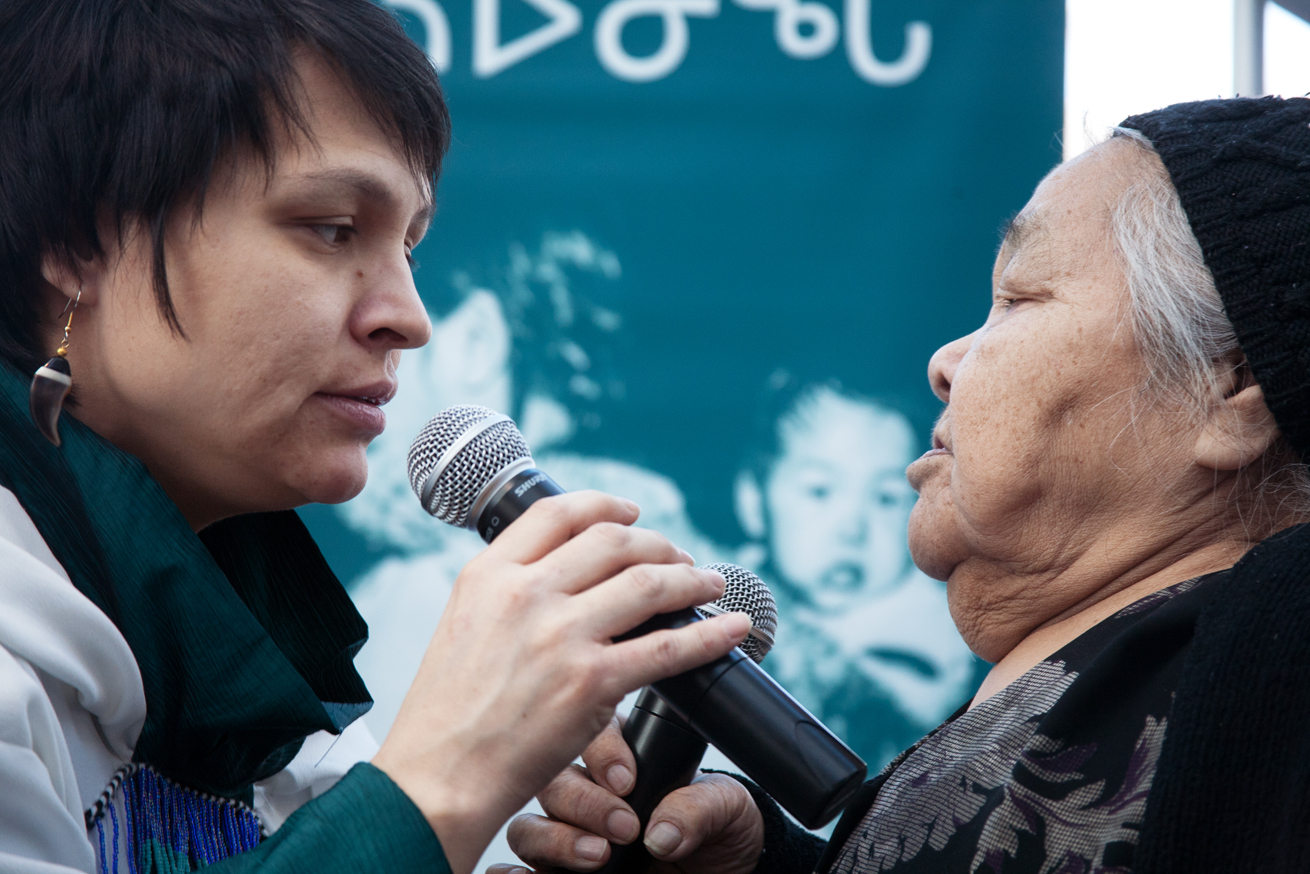ᐄᕕ ᒫᒃ | Evie Mark
ᐄᕕ ᒫᒃ ᐊᒥᓱᐃᓂᒃ ᑐᓴᕐᓂᔮᕐᑎᓯᒍᑎᖃᕈᓐᓇᑐᖅ ᑕᑯᒥᓇᕐᑐᓕᐅᕈᓐᓇᑐᖅ ᐊᒻᒪᓗ ᐃᓕᓭᔨᐅᑦᓱᓂ ᓄᓇᕕᒃ ᓯᕗᓂᑦᓴᕗᒻᒥ ᐱᒋᐅᕐᐸᓕᐊᓯᒪᓂᕐᒥᓂᒃ ᐃᓄᑦᑎᑐᑦ. ᑲᒃᑲᓛᒍᑦᓱᓂ ᓄᓇᓕᒥᓂᒃ ᕿᒣᓯᒪᔪᖅ ᖃᓪᓗᓈᑦ ᓄᓇᖓᓄᑦ ᓅᑦᓱᓂ ᐊᒻᒪᓗ ᐃᕗᔨᕕᒻᒧᑦ ᐅᑎᕋᒥ ᐃᓄᑦᑎᑐᑦ ᐃᓕᓴᕆᐊᓪᓚᕆᐊᖃᕐᓯᒪᔪᖅ ᐊᕐᕌᒍᓗ ᓈᑎᓪᓗᒍ ᐅᖃᕋᓐᓇᓯᑦᓯᐊᑐᕕᓂᐅᑦᓱᓂ. ᓯᕗᓪᓕᒥ, ᐃᑉᐱᒍᓱᑦᑐᕕᓂᖅ ᐃᓄᑦᑎᑑᕐᖃᔦᕐᓯᒪᓕᕋᒥ ᐃᓚᐅᑦᓯᐊᕈᓐᓀᓂᕐᒥᓂᒃ. ᐃᓄᑦᑎᑐᑦ ᐃᓕᓴᕆᐊᓪᓚᑐᕕᓂᖅ ᐊᒻᒪᓗ ᑲᑕᑦᔭᕆᐅᕐᓱᓂ ᑭᓇᐅᓂᕐᒥᓂᒃ ᓱᕐᖁᐃᓇᕐᑎᓯᒍᓐᓇᓕᕐᑐᕕᓂᖅ, ᐱᐅᔪᕆᑦᓯᐊᓂᕐᒥᒃ ᐃᑉᐱᒍᓱᓕᕐᓱᓂ ᐊᒻᒪᓗ ᐅᐱᒪᒋᔭᖃᓕᕐᓱᓂ ᑭᓇᐅᓂᕐᒥᓂᒃ.
ᐃᓄᐃᑦ ᓄᓇᖓ ᐃᓕᒪᑦᓯᐊᑐᖅ ᐃᓄᐃᑦ ᑭᓇᐅᓂᖏᓐᓄᑦ, ᐅᖃᐅᓯᖓᓄᑦ ᐊᒻᒪᓗ ᑲᑕᑦᔭᓂᕐᒧᑦ, ᑖᒃᑯᐊᓗ ᐃᓕᓐᓂᐊᑎᑦᓯᐅᑕᐅᕙᓕᕐᓱᑎᒃ ᐅᕕᒐᕐᓂᓴᓄᑦ 80-ᓂ ᐊᑐᕆᐊᖃᖕᖏᑑᑎᑕᐅᓯᒪᔪᕕᓂᐅᑦᓱᑎᒃ.
ᐃᓄᑦᑎᑐᑦ ᓂᕐᓕᖅ ᐃᑦᔪᐊᖃᑦᑌᓂᖅ. ᐅᖃᐅᓯᖅ ᑳᑦᑐᖅ ᐊᕿᐊᕈᖅ ᓂᑦᔮᑎᓪᓗᒍ ᑳᒧᑦ, ᖁᓗᐊᕐᑐᖅ. “ᑐᑭᓯᒪᒋᐊᖃᕐᑐᒍᑦ ᐊᕙᑎᐅᑉ ᖃᓄᐃᓘᕐᓂᖓᓂᒃ ᑌᒣᒻᒪᑦ, ᐱᑐᑦᓯᒪᔪᖅ ᐅᖃᐅᓯᕐᒧᑦ.” ᑕᕐᕋᐅᑉ ᐊᕙᑎᖓᓂ ᓂᐲᑦ ᐃᓕᓐᓂᐊᑎᑦᓯᐅᑕᐅᕙᑦᑐᕕᓃᑦ ᑲᑕᑦᔭᓂᑎᒍᑦ:
“ᓯᕗᓪᓕᕕᓂᕗᑦ ᐱᕐᓕᕋᕐᐸᑐᕕᓂᐅᒐᒥᒃ ᑐᓴᕐᓂᔮᕈᑎᓕᐅᕐᑐᕕᓃᑦ ᐊᕿᐊᕉᑉ ᑳᑦᑑᑉ ᓂᐱᖓᓂᒃ. ᖃᓄᐃᑦᑐᑰᕐᐸᓂᕐᒪᖔᑕ ᐱᒐᓱᐊᒻᒪᕆᑦᓱᑎ ᐃᓱᒪᒋᑐᐃᓐᓇᓱᒍ ᐅᐱᓐᓀᓘᕐᑐᖓ. ᓲᓱᑦᓴᓂᕐᓄᑦ ᐊᒻᒪᓗ ᐅᐱᓐᓀᓘᕐᓂᓄᑦ, (ᑲᑕᑦᔭᓕᕋᒪ) ᐊᕿᐊᕈᕐᒥᒃ ᑳᑦᑐᒥᒃ ᐃᑦᔭᓯᒐᓱᐊᑐᐃᓐᓇᖏᑦᑐᖓ, ᑐᑭᓯᒪᒋᐊᖃᕐᑐᖓ ᑐᓴᕐᓂᔮᕐᑎᓯᐅᑎᐅᑉ ᐱᒋᐊᕐᕕᒋᓯᒪᔭᖏᓐᓂᒃ.”
ᐃᓕᓭᔨᐅᓂᕐᒥᓄᑦ, ᐄᕕ ᓯᕗᓂᕐᒥ ᐃᓕᓐᓂᐊᑎᑦᓯᐅᑕᐅᖁᔨᔪᖅ ᐃᓄᑦᑎᑐᑦ ᐱᓇᓱᐊᕆᐅᕐᓴᑐᓂᒃ ᐊᒻᒪᓗ ᐃᓕᓴᕐᕕᔪᐊᓂ. ᐅᓪᓗᒥ ᐃᓕᓭᔨ ᓄᓇᕕᒃ ᓯᕗᓂᑦᓴᕘᒥ, ᐳᕐᑐᓂᕐᓭᑦ ᐅᖓᑖᓃᑦᑐᓂᒃ ᐊᒻᒪᓗ ᐱᓇᓱᐊᕆᐅᕐᓴᕕᒻᒥ ᐃᓕᓴᕐᑐᓴᓂᒃ ᐱᓇᓱᒐᖅ ᐃᓕᓐᓂᐊᑎᑦᓯᓂᕐᓄᑦ ᓄᓇᕕᒻᒥᐅᑦ ᐱᕙᓪᓕᐊᒍᑎᒋᓯᒪᔭᖏᓐᓂᒃ ᐊᒻᒪᓗ ᐃᓗᒡᒍᓯᖓᓂᒃ.
ᐄᕕ ᒫᒃ ᑕᑯᓐᓇᐅᔮᕐᑎᓯᓯᒪᔪᖅ ᑲᑕᑦᔭᓱᓂ ᓯᓚᕐᔪᐊᓕᒫᒥ, ᐊᐅᓚᔫᓕᐅᕐᑎᐅᓱᓂᓗ ᐊᒻᒪᓗ ᒥᕐᓱᑎᐅᑦᓱᓂ.
Evie Mark, artiste multidisciplinaire et enseignante à Nunavik Sivunitsavut, partage son développement personnel avec l’inuktitut. Enfant, elle a quitté sa communauté pour vivre dans le sud du pays et, lorsqu’elle est revenue à Ivujivik, elle a dû retrouver son inuktitut et il lui a fallu un an pour le reparler couramment. Au début, elle se sentait déconnectée parce qu’elle ne parlait pas la langue. Réapprendre sa langue, ainsi que le chante de gorge, a solidifié son identité, sa confiance en soi et sa fierté. «Lorsque vous apprenez votre culture, vous en apprenez davantage sur vous et cela vous donne un sentiment de fierté»
La terre où les gens vivent est intimement liée à leur identité, à leur langue et au chant de gorge qui est enseigné aux jeunes générations après la levée de l’interdiction de la pratique dans les années 80. Le mot pour oie en inuktitut est Nirliq, qui est le son qu’ils imitent. Le mot qui signifie faim est le gargouillement du ventre qui a faim, Quluarartuq. « Nous devons comprendre le comportement de l’environnement qui est, par conséquent, connecté à la langue. » Les sons reliés à l’environnement nordique ont été enseignés à travers le chant de gorge : «Nos ancêtres vivaient dans la famine et quand ils ont composé une chanson sur le son d’un estomac affamé, je ne peux qu’imaginer ce qu’ils ont vécu. Avec respect et honneur (lorsque je fais du chant de gorge), je ne vais pas simplement essayer de ressembler à un estomac affamé, je dois comprendre l’histoire de cet art. »
En tant qu’enseignante, Evie souhaite que les cours soient enseignés en inuktitut dans les collèges et les universités. Elle est actuellement professeure à Nunavik Sivunitsavut, un programme postsecondaire et pré-universitaire d’enseignement de l’histoire et la culture des Nunavimmiut. Evie Mark a effectué des tournées de chants de gorge à l’internationale, elle est également cinéaste et couturière.
Evie Mark, multidisciplinary artist and teacher at Nunavik Sivunitsavut shares her personal growth with Inuktitut. As a child she left her community to live down south and when she came back to Ivujivik she had to regain her Inuktitut and it took her a year to be fluent. At first, she felt disconnected not speaking the language. Relearning Inuktitut as well as throat singing has stabilized her identity, her self-confidence and being proud of who she is. “When you get to learn your culture, you get to learn more about who you are and it gives you a sense of pride”
The land where people live is very connected to who they are, their language and also throat singing, which is being taught to younger generations after the ban of the practice was lifted in the 80’s. The word for goose in Inuktitut is Nirliq which is the sound they mimic. The word for hunger is the growling of a hungry belly, Quluarartuq. “We have to understand the behavior of the environment therefore, it connects with the language.” The sounds of the northern environment were taught through throat singing: “Our ancestors use to live starvation so when they composed a song about the sound of a hungry stomach, I can only imagine what they went through. With respect and honor, (when I throat sing) I’m not just going to try to sound like a hungry stomach, I have to understand the history of the art.”
As a teacher, Evie wishes in the future that courses will be taught in Inuktitut in colleges and universities. She is currently a teacher at Nunavik Sivunitsavut, a post-secondary and pre-college teaching program in Nunavimmiut history and culture. Evie Mark has performed throat signing internationally, she is also a filmmaker and a seamstress.
ᐊᓪᓚᑐᖅ | Texte de | Text by: Olivia Lya Thomassie
Evie Mark / Akinisie Sivuarapik / Pauyungie Nataraaluk / Aulla Tullaugak
ᐊᑦᔨᓕᐊᕕᓂᕐᒥᓂᒃ ᐊᑐᕐᑕᐅᑎᑦᓯᓯᒪᔪᑦ / Crédits photos / Photos credits: Robert Fréchette, Michel Patry


